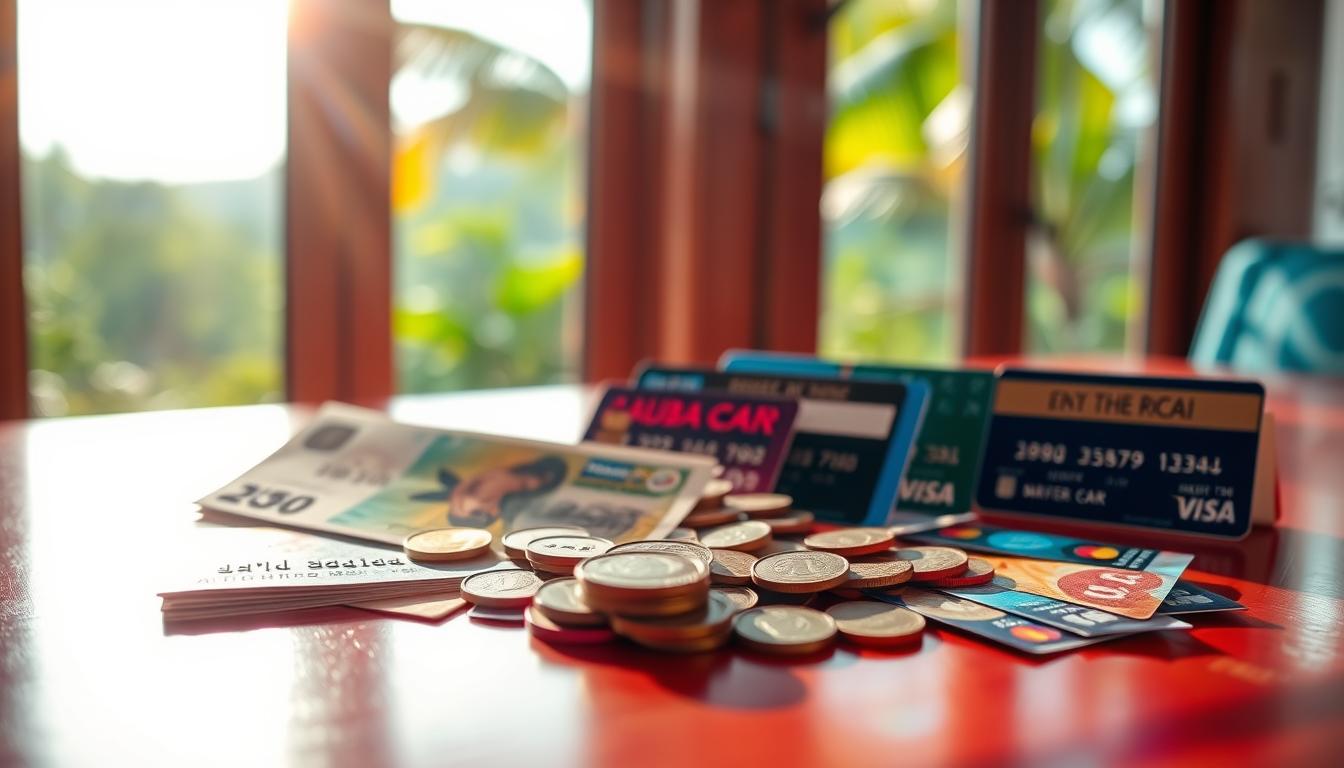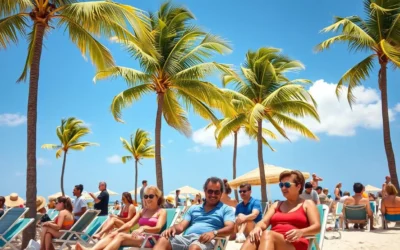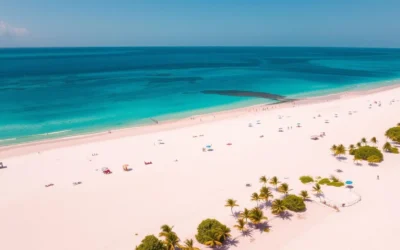✓ Accommodations✓ Flights✓ Rental Cars✓ Tours & Activities
Did you know that in Aruba, you can use both the local Aruban florin (AWG) and the U.S. dollar (USD) interchangeably? This dual currency system makes it one of the most traveler-friendly destinations in the Caribbean.
Understanding the island’s currency and payment options is key to optimizing your trip. Whether you’re paying with cash or card, knowing the exchange rate and local practices can save you time and money.
In this guide, you’ll learn how to navigate the island’s financial landscape, from managing cash to using credit cards. We’ll also share tips to avoid unnecessary fees and make the most of your budget.
Stay tuned to discover how to balance convenience and cost during your stay. Let’s dive into the essentials of Aruba’s unique currency system!
Overview of Aruba’s Currency Landscape
Navigating the currency system in Aruba is simpler than you might think. The island operates on a dual currency system, making it easy for visitors to use both the local Aruban florin (AWG) and the U.S. dollar (USD). This flexibility ensures a smooth experience whether you’re dining at a restaurant or shopping at a local store.
Understanding the Aruban Florin (AWG)
The Aruban florin is the official currency of the island. It’s divided into 100 cents, with coins available in denominations of 5, 10, 25, and 50 cents, as well as 1, 2.5, and 5 florin. Banknotes come in 10, 25, 50, 100, and 200 florin. Locals and tourists alike use these denominations for daily transactions.
Being familiar with the AWG can help you avoid unfavorable exchange rates. Many places, including hotels and banks, offer competitive rates for converting your money.
US Dollar Acceptance and Traveler’s Checks
One of the perks of visiting Aruba is the widespread acceptance of USD. Most restaurants, stores, and hotels will gladly take U.S. dollars, often providing change in both USD and AWG. Traveler’s checks are also commonly accepted, especially at larger establishments.
If you’re planning to use cash, it’s worth noting that ATMs on the island dispense both currencies. Credit and debit cards are widely accepted, making it easy to manage your spending.
| Currency | Denominations | Common Usage |
|---|---|---|
| Aruban Florin (AWG) | Coins: 5c, 10c, 25c, 50c, 1f, 2.5f, 5f Banknotes: 10f, 25f, 50f, 100f, 200f | Daily transactions, local markets |
| U.S. Dollar (USD) | Bills: $1, $5, $10, $20, $50, $100 | Hotels, restaurants, tourist spots |
Understanding the local currency landscape will help you plan your trip better. Whether you’re using cash or card, being aware of the options ensures a hassle-free experience.
Exchange Rates in Aruba
Exchange rates play a big role in managing your travel budget. Whether you’re converting U.S. dollars to the local currency or using cash for daily expenses, understanding how rates work can save you money. Let’s break down the key details to help you navigate Aruba’s exchange system.
Bank and Shop Rates
Banks and shops in Aruba often offer different rates for currency exchange. Banks typically use the official mid-market rate, which is the fairest option. Shops, on the other hand, may apply a marked-up rate to cover their costs. For example, supermarkets and gas stations often use a slightly lower rate compared to banks.
It’s a good idea to compare rates before exchanging money. Many establishments, including restaurants and hotels, may charge a higher fee for convenience. Always check the Central Bank of Aruba’s daily published rates to ensure you’re getting the best deal.
Mid-Market vs. Marked-Up Rates
The mid-market rate is the real-time rate banks use for currency exchange. It’s the most transparent and cost-effective option. Marked-up rates, however, include additional fees that can increase your costs. For instance, some shops may apply a rate of 1.80 AWG per USD, while the mid-market rate might be 1.77 AWG.
When exchanging money, always ask if the rate includes any hidden fees. Using a bank or a trusted currency exchange service can help you avoid unnecessary charges. Monitoring the daily rates can also ensure you get the best value for your money.
Payment Methods and Tips in Aruba
Managing your finances while traveling can be stress-free with the right payment methods. Whether you prefer using a card or carrying cash, understanding your options ensures a smooth experience. Here’s what you need to know to make the most of your spending.
Using Credit and Debit Cards
Credit and debit cards are widely accepted across the island. Major brands like Visa, MasterCard, and American Express are commonly used in hotels, restaurants, and shops. Using a card offers convenience and security, especially for larger purchases.
Travel debit cards, such as those from providers like Wise, are a smart choice. They often come with low transaction fees and competitive exchange rates. Always check with your card provider to understand any foreign fees before your trip.
Dynamic Currency Conversion Cautions
When using your card, you may encounter dynamic currency conversion (DCC). This option allows you to pay in your home currency instead of the local one. While it might seem convenient, it often comes with poor exchange rates and hidden fees.
To avoid unnecessary costs, always decline DCC and opt to pay in the local currency. This ensures you get the best rate and avoid extra charges. Double-check your receipts to confirm the correct currency was used for the transaction.
- Use credit and debit cards for convenience and security.
- Decline dynamic currency conversion to save on fees.
- Consider a travel debit card for low-cost transactions.
By choosing the right payment methods and staying informed, you can enjoy a hassle-free trip. Whether you’re dining out or shopping, these tips will help you make the most of your budget.
ATMs, Banks, and Security Measures in Aruba
Accessing cash during your trip is made easy with Aruba’s widespread ATM network. Whether you’re in a bustling city or a quiet neighborhood, you’ll find machines at banks, gas stations, and supermarkets. This convenience ensures you’re never far from your next transaction.
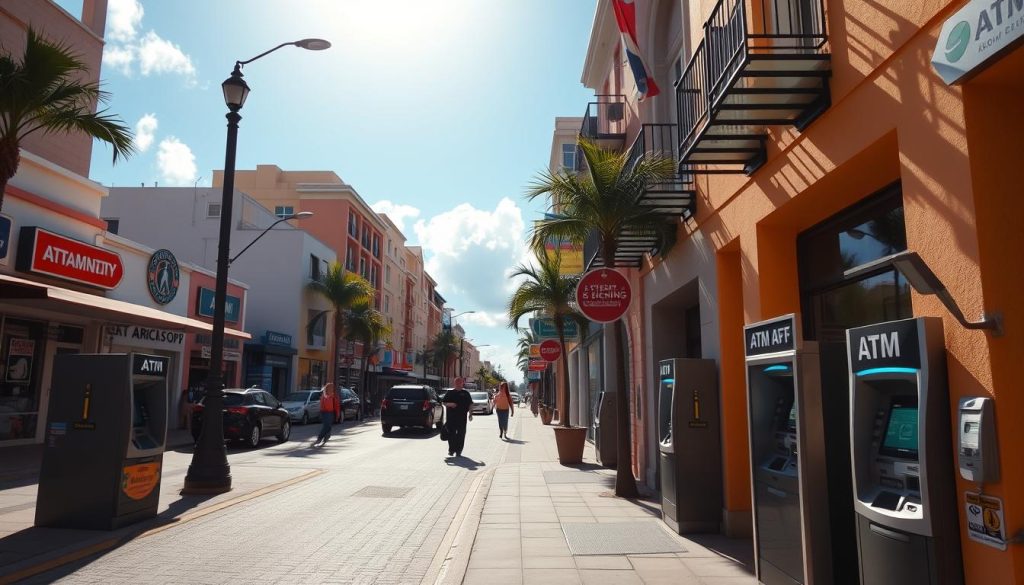
When using an ATM, always confirm it dispenses the local currency (AWG). Most machines offer a choice between AWG and USD, but opting for the local currency can save you on exchange fees. Double-check the amount before completing the transaction.
ATM Locations and Usage Tips
ATMs are widely available across the island, making it simple to withdraw cash whenever needed. You’ll find them at major banks, shopping centers, and even some hotels. For added security, choose machines located inside bank branches. These are less likely to be tampered with and reduce the risk of fraud.
Before your trip, check with your phone provider to ensure compatibility with Cirrus or Visa Plus networks. This step ensures smooth access to your funds without unexpected issues. It’s also a good idea to inform your bank of your travel plans to avoid any holds on your account.
Staying Safe with Skimming Alerts
While ATMs in Aruba are generally safe, it’s important to stay vigilant. Skimming devices can be used to steal your card information. Always inspect the machine for any unusual attachments or loose parts before inserting your card.
Protect your PIN by covering the keypad with your hand. Avoid using ATMs in poorly lit or isolated areas, especially late at night. After completing your transaction, take your receipt and check your account balance regularly for any unauthorized activity.
“Safety first—always trust your instincts when using an ATM. If something feels off, find another machine.”
| ATM Safety Tips | Why It Matters |
|---|---|
| Use ATMs inside bank branches | Reduces the risk of tampering and fraud |
| Inspect the machine before use | Helps detect skimming devices |
| Cover the keypad when entering your PIN | Prevents others from seeing your code |
| Take your receipt and check your balance | Ensures accuracy and detects unauthorized transactions |
By following these tips, you can enjoy a stress-free experience while managing your finances in Aruba. Whether you’re withdrawing cash or checking your balance, staying informed and cautious is key.
Currency Exchange Tips for Travelers
Getting the best exchange rate can make a big difference in your travel budget. Knowing where and when to exchange money ensures you save time and avoid unnecessary fees. Here’s how to navigate the process like a pro.
Avoiding Airport and Hotel Exchange Pitfalls
Exchanging money at the airport or your hotel might seem convenient, but it often comes with hidden costs. These locations typically offer less favorable rates and higher fees. For example, some airport kiosks charge up to 15% more than local shops.
To secure a better deal, consider exchanging a small amount in advance before your trip. This ensures you have cash on hand without relying on costly services. Once you arrive, look for local exchange offices in city centers, as they often provide more competitive rates.
Comparing Rates for Maximum Savings
Always compare the offered exchange rate with the live mid-market rate. This helps you identify fair deals and avoid overpaying. Many local shops and banks publish their rates online, making it easy to plan ahead.
If you’re unsure where to start, ask locals for recommendations. They often know the best spots for currency exchange. Researching your options before your trip can save you both time and money.
| Exchange Option | Pros | Cons |
|---|---|---|
| Airport Kiosks | Convenient, available 24/7 | High fees, poor rates |
| Hotel Services | Easy access | Marked-up rates, hidden fees |
| Local Exchange Shops | Competitive rates, lower fees | May require research |
By planning ahead and comparing your options, you can avoid common pitfalls and get the most value for your money. Whether you’re exchanging cash or using a card, these tips will help you stay within budget.
Managing Cash vs. Card Usage
Balancing cash and card usage can make your trip smoother and more cost-effective. Both options have their benefits, and knowing when to use each can save you time and money.
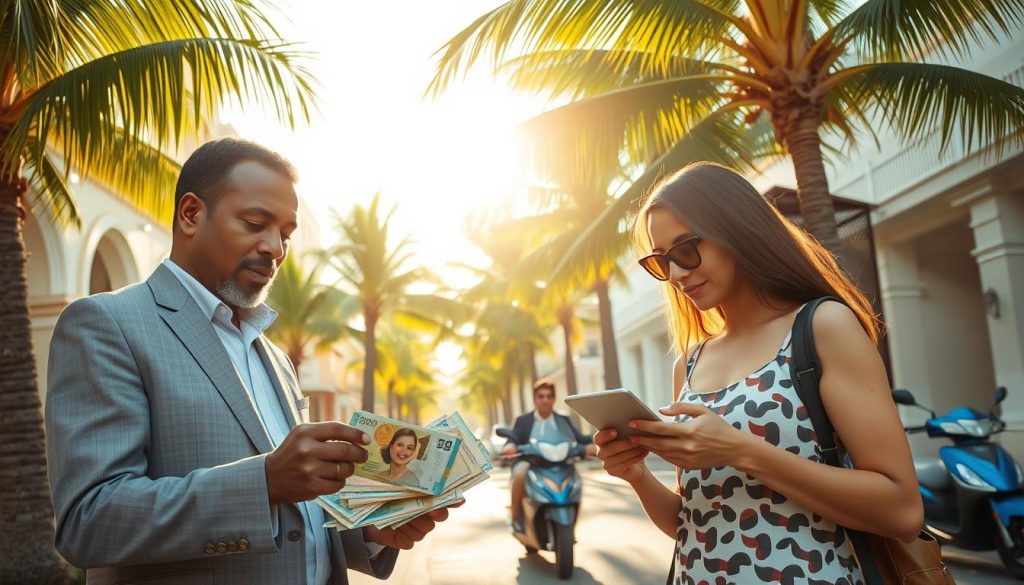
When to Use Cash in AWG
Carrying cash in the local currency (AWG) is ideal for small purchases, tips, and transactions at local markets. Many smaller establishments prefer cash, and it’s often the only option for street vendors or rural areas.
Having a balance in AWG also ensures you’re prepared for emergencies. ATMs are widely available, but it’s wise to have some cash on hand for immediate needs. This avoids reliance on machines or potential card issues.
Advantages of Card Payments
Using a card is convenient for larger purchases, dining, and accommodations. Most hotels, restaurants, and shops accept major credit and debit cards. This reduces the need to carry large amounts of cash and provides added security.
Travel debit cards, like those from Wise, are a great backup. They offer low transaction fees and competitive exchange rates, making them a smart choice for managing your budget.
Scenarios for USD to AWG Exchange
In some cases, exchanging USD to AWG can be advantageous. For example, local markets or smaller shops may offer better deals in the local currency. Always compare rates to ensure you’re getting the best value.
- Use cash for small purchases, tips, and local markets.
- Opt for a card for larger expenses and added security.
- Carry a mix of AWG and USD to handle different situations.
- Consider a travel debit card for low fees and convenience.
By understanding when to use cash or card, you can manage your finances efficiently and enjoy a hassle-free trip. Whether you’re shopping, dining, or exploring, these tips will help you make the most of your budget.
Budgeting Your Trip: How Much Money to Take
Planning your budget for a trip can feel overwhelming, but it doesn’t have to be. Knowing your daily expenses helps you enjoy your vacation without worrying about overspending. Whether you’re a budget traveler or looking for luxury, here’s how to plan your finances.
Daily Spending Estimates for Different Budgets
For budget travelers, daily expenses average around $139 AWG. This includes affordable meals, public transport, and free or low-cost attractions. Mid-range travelers can expect to spend about $325 AWG daily, covering nicer meals, taxis, and paid activities.
Luxury travelers should budget around $684 AWG per day. This includes fine dining, private tours, and upscale accommodations. Planning ahead ensures you can enjoy your trip without financial stress.
Planning for Meals, Transport, and Attractions
Meals are a significant part of your budget. Budget travelers can enjoy breakfast for $4 AWG, lunch for $8 AWG, and dinner for $16 AWG. Mid-range meals cost around $68 AWG daily, while luxury dining can reach $150 AWG.
Transportation costs vary too. Public buses are affordable, while taxis are pricier. Attractions like museums or tours can add up, so prioritize what matters most to you.
- Use a travel card to avoid high exchange fees.
- Carry some cash for small purchases and tipping.
- Plan meals and activities to balance your costs.
By understanding your daily money needs, you can focus on making memories, not managing expenses. Whether you’re dining at a restaurant or exploring attractions, these tips will help you stay on budget.
Payment Solutions: Travel Debit Cards and Wise
Managing your money abroad doesn’t have to be complicated with the right tools. Travel debit cards, like the Wise multi-currency card, offer a seamless way to handle finances while avoiding unnecessary fees. These cards are designed to simplify currency exchange and provide transparency in every transaction.
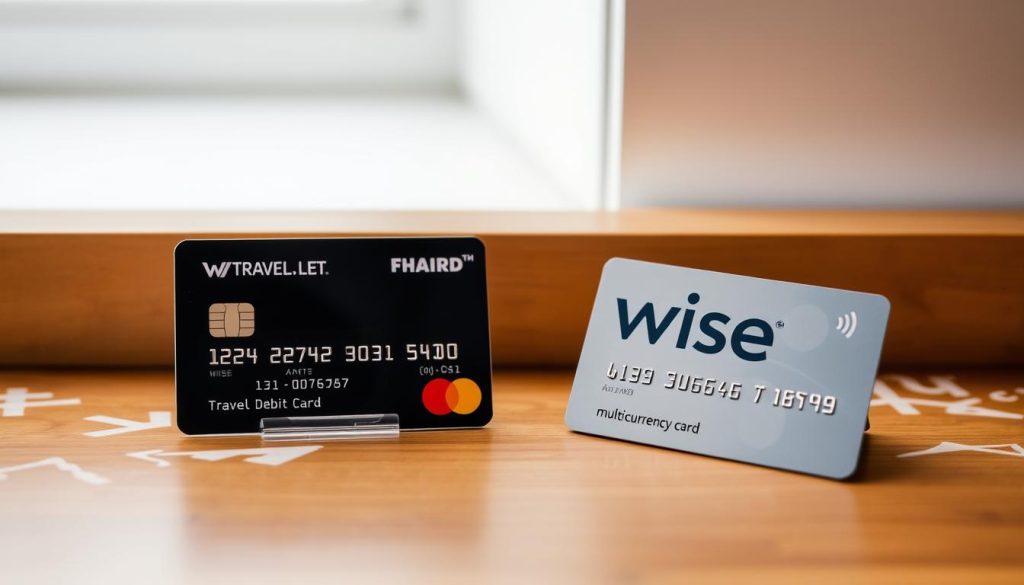
Benefits of the Wise Multi-Currency Card
The Wise multi-currency card is a game-changer for travelers. It allows you to hold and convert money in over 50 currencies at the mid-market rate. This means you avoid the marked-up rates often charged by banks or exchange services.
Another advantage is the low foreign transaction fee. For example, Wise charges just 18 cents per transaction, saving you money compared to traditional cards. Whether you’re withdrawing cash or making purchases, this card ensures you get the best value.
Comparing Fees and Foreign Transaction Costs
When choosing a payment solution, it’s important to compare fees. Traditional debit cards often come with high foreign transaction fees and poor exchange rates. In contrast, the Wise multi-currency card uses the mid-market rate and charges minimal fees.
For instance, using the Wise card can save you up to three times compared to standard cards. This makes it an ideal choice for frequent travelers or those on a budget. Always check the terms of your card to avoid hidden costs.
- Use a travel debit card for low fees and convenience.
- Opt for a multi-currency card like Wise for competitive exchange rates.
- Compare fees to ensure you’re getting the best deal.
By choosing the right payment solution, you can focus on enjoying your trip without worrying about finances. Whether you’re dining out or shopping, these tips will help you make the most of your budget.
Aruba: Ultimate Travelers Guide to Currencies & Payments
Choosing the right payment method can make your trip smoother and more enjoyable. Whether you prefer using cash, a card, or a travel debit card, understanding your options ensures a hassle-free experience. Here’s a breakdown of the most common methods and how they can work for you.
Cash: The Traditional Choice
Carrying cash in the local currency is ideal for small purchases, tips, and transactions at local markets. Many smaller establishments prefer cash, and it’s often the only option for street vendors or rural areas. Having a balance in the local currency also ensures you’re prepared for emergencies.
Credit and Debit Cards: Convenience and Security
Using a card is convenient for larger purchases, dining, and accommodations. Most hotels, restaurants, and shops accept major credit and debit cards. This reduces the need to carry large amounts of cash and provides added security. Always check with your card provider to understand any foreign transaction fees before your trip.
Travel Debit Cards: Smart and Cost-Effective
Travel debit cards, like the Wise multi-currency card, offer a seamless way to handle finances while avoiding unnecessary fees. These cards allow you to hold and convert money in multiple currencies at competitive rates. For example, Wise charges just 18 cents per transaction, saving you money compared to traditional cards.
Comparing Fees and Secure Banking
When choosing a payment solution, it’s important to compare fees. Traditional debit cards often come with high foreign transaction fees and poor exchange rates. In contrast, travel debit cards use the mid-market rate and charge minimal fees. Always check the terms of your card to avoid hidden costs.
- Use cash for small purchases, tips, and local markets.
- Opt for a card for larger expenses and added security.
- Consider a travel debit card for low fees and convenience.
By understanding your payment options and comparing fees, you can choose the most economical and secure method for your trip. Whether you’re dining out or shopping, these tips will help you make the most of your budget.
Tips for Smart Spending and Savings in Aruba
Maximizing your travel budget requires smart strategies and local insights. By combining practical tips with a bit of planning, you can save money and enjoy your trip even more. Here’s how to make the most of your finances while exploring.
Using Public Transport and Locals’ Advice
Public transport is a cost-effective way to get around. Buses and shared rides are often cheaper than taxis and offer a chance to experience local life. Use your phone to research routes and schedules in advance to save time.
Locals can also provide valuable advice. Ask for recommendations on affordable dining spots, hidden gems, and budget-friendly activities. This service of insider tips can help you avoid tourist traps and enjoy authentic experiences.
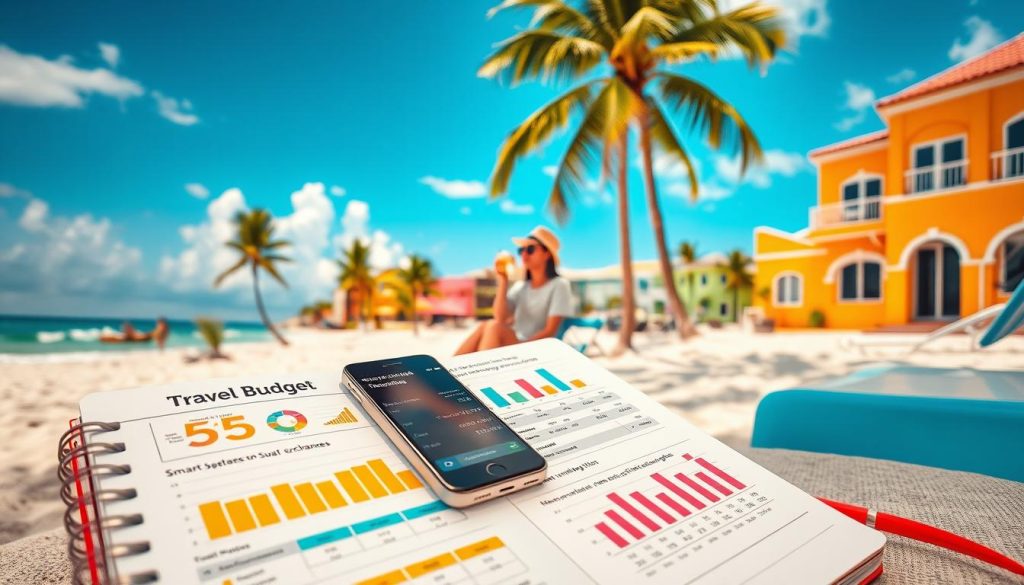
How to Find the Best Deals on Currency Exchange
Finding the best exchange rates is a smart idea. Avoid airport and hotel kiosks, as they often charge higher fees. Instead, compare rates at local stores or banks for better deals.
Using a service like Wise can also save you money. Their multi-currency card offers competitive rates and low fees, making it a great way to manage your finances. Always plan your currency exchange in advance to avoid last-minute markups.
- Use public transport to save on travel costs.
- Seek locals’ advice for budget-friendly tips.
- Compare exchange rates at multiple locations.
- Consider using a multi-currency card like Wise.
By following these tips, you can stretch your budget further and focus on enjoying your trip. Whether you’re exploring the city or exchanging currency, smart spending makes all the difference.
Conclusion
Understanding the local currency and payment options can make your trip smoother and more enjoyable. Whether you’re using cash or a card, knowing the exchange rate and local practices ensures you get the most value for your money.
Make sure to research the latest rates and fee structures before your trip. This helps you avoid unnecessary costs and maximize your budget. Using a travel debit card can also save you on foreign transaction fees and provide competitive exchange rates.
By staying informed, you can enjoy a hassle-free and cost-effective experience. Check live rates and choose secure payment methods to make the most of your journey. Being prepared ensures a smoother and more enjoyable adventure.
The above is subject to change.
Check back often to TRAVEL.COM for the latest travel tips and deals.
